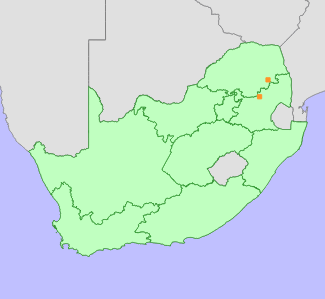|
Scientific Name | Brachystelma setosum Peckover |
Higher Classification | Dicotyledons |
Family | APOCYNACEAE |
National Status |
Status and Criteria | Vulnerable D2 |
Assessment Date | 2013/05/30 |
Assessor(s) | L. von Staden |
Justification | Known from only two, disjunct locations, but possibly more common. However, no further collections have been made since this species was described in 1994. It is potentially threatened by competition from alien invasive plants, habitat loss to development and habitat degradation due to overgrazing. |
Distribution |
Endemism | South African endemic |
Provincial distribution | Limpopo, Mpumalanga |
Range | Strydom Tunnel to Dullstroom. |
Habitat and Ecology |
Major system | Terrestrial |
Major habitats | Ohrigstad Mountain Bushveld, Steenkampsberg Montane Grassland |
Description | Shallow, greyish soils among rocky outcrops in montane grassland. |
Threats |
| Potentially threatened by competition from alien invasive pines and development at Dullstroom, and habitat degradation due to overgrazing on the Abel Erasmus Pass. |
Population |
Population trend | Stable |
Assessment History |
Taxon assessed |
Status and Criteria |
Citation/Red List version | | Brachystelma setosum Peckover | VU D2 | 2014.1 | | Brachystelma setosum Peckover | Threatened | 2013.1 | | Brachystelma setosum Peckover | Threatened | Raimondo et al. (2009) | |
Bibliography |
Peckover, R.G. 1994. An unusual Brachystelma, B. setosum Peckover Sp. nov. (Asclepiadaceae) from the Dullstroom area, Eastern Transvaal. Aloe 31(3/4):76-78.
Raimondo, D., von Staden, L., Foden, W., Victor, J.E., Helme, N.A., Turner, R.C., Kamundi, D.A. and Manyama, P.A. 2009. Red List of South African Plants. Strelitzia 25. South African National Biodiversity Institute, Pretoria.
|
Citation |
| von Staden, L. 2013. Brachystelma setosum Peckover. National Assessment: Red List of South African Plants version 2024.1. Accessed on 2025/11/30 |
 Comment on this assessment
Comment on this assessment


